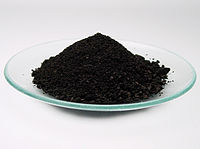
Photo from wikipedia
The zerovalent iron (Fe0) nanomaterials tend to be spontaneously oxidized in the presence of oxygen. This leads to the formation of interface composed of iron core and thin iron oxide… Click to show full abstract
The zerovalent iron (Fe0) nanomaterials tend to be spontaneously oxidized in the presence of oxygen. This leads to the formation of interface composed of iron core and thin iron oxide shell. These structures are frequently observed with transmission electron microscope but, at the same time, it is hard to determine the precise structural and chemical composition of oxide shell. This feature is very important for possible applications of Fe0 nanostructures. Hence, the present work aims to deliver more detailed insights in this topic. The investigations are performed for the iron nanochains prepared in the magnetic-field-induce reduction of FeCl3 by NaBH4. The high-resolution transmission electron microscopy, electron energy loss spectroscopy, and x-ray photoemission spectroscopy confirm that the iron nanochains are covered by very thin oxide layer not exceeding over 3 nm. Moreover, the detailed XPS analyses of O 1s and Fe 2p lines indicate that the iron oxide shell reveals Fe3O4 nature. Moreover, this work demonstrated that some by-products of the reaction containing boron are presented in the sample even after a removal of the thin iron oxide shell by Ar+ treatment.
Journal Title: Nanotechnology
Year Published: 2023
Link to full text (if available)
Share on Social Media: Sign Up to like & get
recommendations!